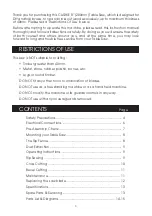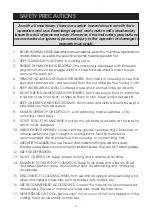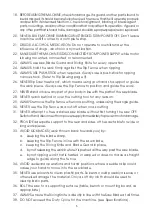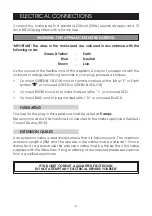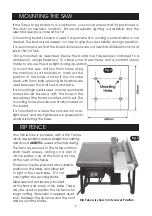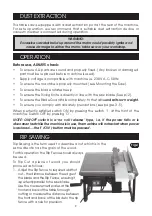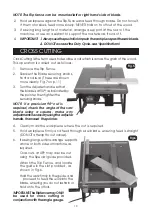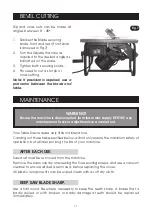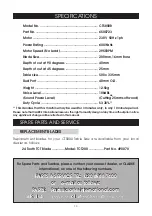
2.
Hold workpiece against the Rip Fence and feed through blade. Do not force it.
If the motor slows, feed more slowly. NEVER hold on to offcut of the wood.
3.
If sawing long lengths of material, arrange a support at the rear of the
machine, or use an assistant to support the material as it runs off.
4.
IMPORTANT! 1. Always use the push stick to push the workpiece past the saw blade.
2.. DO NOT exceed the Duty Cycle..see ‘Specifications’
10
This operation is carried out as follows:
1.
Remove the Rip Fence.
2.
Slacken the Blade securing knobs,
front and rear. (These are shown
more clearly Fig.7 on p.11)
3.
Turn the Adjuster handle so that
the blade is at 90
O
, as indicated by
the pointer, then tighten the
securing knobs.
NOTE: If a precision 90
O
cut is
required, check the angle of the saw
blade using a square, make any
adjustments necessary using the adjuster
handle, then reset the pointer.
4.
Clearly mark the workpiece where the cut is required.
5.
Hold workpiece firmly and feed through saw blade, ensuring feed is straight
(DO NOT attempt to cut curves).
6.
If sawing long sections arrange supports
at one or both sides of machine, as
required.
Cross cuts at 45
O
may also be cut
using the Special guide provided.
Attach the Rip Fence, and locate
the guide in the slot provided, as
shown in Fig.6.
Hold the work firmly in the guide, and
proceed to feed the work into the
blade, ensuring you do not restrain or
hold on to the offcut.
I
MPORTANT: The Ripfence may ONLY
be used for cross cutting in
conjunction with the angle gauge.
Fig.6
CROSS CUTTING
Cross Cutting is the term used to describe a cut which is across the grain of the wood.
Fig.5
NOTE: The Rip fence can be mounted left or right hand side of blade.



